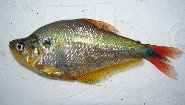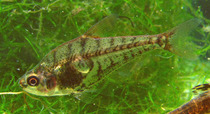Glass headstander
The Glass headstander lives in the benthopelagic, freshwater environment.
Glass Headstander - Tiny Fish With Huge Appetites
 The glass headstander (Charax stenopterus) is actually the common name for two species of small South American freshwater fish ' Charax stenopterus and Charax gibbosus. Both species are similar, except in color, that some taxonomists think they may be two subspecies instead of two separate species. But the C. stenopterus species is found in rivers and river basins of Argentina, Brazil, Uruguay and Paraguay while the C. gibbosus is found only in Guyana and Suriname.
The glass headstander (Charax stenopterus) is actually the common name for two species of small South American freshwater fish ' Charax stenopterus and Charax gibbosus. Both species are similar, except in color, that some taxonomists think they may be two subspecies instead of two separate species. But the C. stenopterus species is found in rivers and river basins of Argentina, Brazil, Uruguay and Paraguay while the C. gibbosus is found only in Guyana and Suriname.
Back in 1894 when the Europeans first discovered C. stenopterus, scientists and taxonomists christened it Asiphonichthys stenopterus. This classification has since been revised to Charnax stenopterus. But no matter what you call it, the glass headstander is a tiny fish with a huge appetite. Keeping the species in captivity can be difficult but they can be found in the pet trade.
Physical Description
The glass headstander gets its common name from its mostly transparent body, best visible when the fish is only a couple of months old. Adults loose this transparentcy as they get older, turning onto a shiny silver color with a blue spot behind the gills and a thin yellow dorsal spine. Individuals often have slight brown stripes running from the top to bottom of the fish and a visible yellowish-tan spine, clearly visible inside of the body. The internal organs vary in coloration depending on how hungry the fish is. A fish that has just eaten will have a brown or red stomach that appears like a brown spot behind the gills. It also seems to stand on its head when resting, which is a majority of the time while not eating.
These small predators grow to a mere 4.9 inches (12.5 cm) long, but fish in pet stores or aquarium supply stores are often much smaller because they are babies. Always ask how large an adult will grow before purchasing a fish. They have the silhouettes of thin piranha but lack the protruding jaws. They do have large teeth in relation to their size. Their eyes are often gold or yellow colored.
Life Cycle and Behavior
Unfortunately, not much is known about the wild behavior of glass headstanders. They prefer staying in small schools of their own species and will eat just about any other fish they can get a hold of. This makes them difficult to keep in captivity unless a person is willing to keep just glass headstanders in an aquarium. Males and females are almost identical, although the female’s ovipositor or egg-laying tube is sometimes just barely seen poking out from the belly close to the tail.
Breeding the glass headstander in captivity is difficult primarily because their spawning habits are unknown. Most glass headstanders in the pet trade are wild-caught. It is unknown what natural predators glass headstanders have in the wild beside man because the adults viciously defend themselves. They can be killed from parasites such as the small worm or flukes in the Genarchella genus.
Picture of the Glass Headstander by Cláudio Dias Timm, licensed under the Creative Commons Attribution 2.0 Generic license.
Common names
Corcunda in Portuguese (Português)
Dentudo transparente in Spanish (español)
Dientudo transparente in Spanish (español)
Glass headstander in English
Lambari-transparente in Unknown
Lambari-vidro in Portuguese (Português)


Original source: FishBase
Permission: Some rights reserved
Family : Characidae
Genus : Charax
Species : Charax stenopterus
Authority : Cope, 1894
